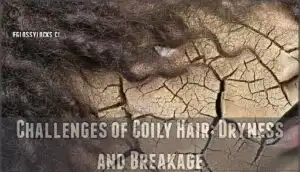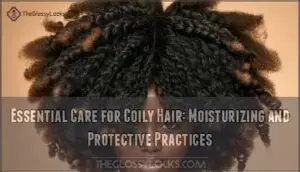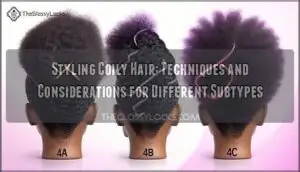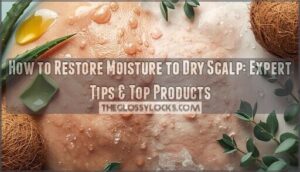This site is supported by our readers. We may earn a commission, at no cost to you, if you purchase through links.
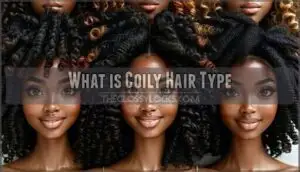 Coily hair type represents the tightest curl pattern in hair classification, featuring densely packed zigzag coils that form distinct spirals.
Coily hair type represents the tightest curl pattern in hair classification, featuring densely packed zigzag coils that form distinct spirals.
You’ll find three subtypes: 4A displays visible cork-screw curls, 4B forms angular S-patterns with less definition, and 4C shows the tightest coils with minimal curl visibility.
Your coily hair’s unique structure comes from asymmetrical follicles that create curved keratin proteins, giving it that signature springy bounce.
This hair type shrinks up to 75% of its actual length and requires specialized moisture retention techniques.
While coily hair offers incredible versatility for protective styling, it faces specific challenges including increased fragility and dryness that smart care routines can address.
Table Of Contents
- Key Takeaways
- Understanding Coily Hair Types and Their Unique Characteristics
- The Science of Coily Hair: Structure and Texture Variations
- Challenges of Coily Hair: Dryness and Breakage
- Essential Care for Coily Hair: Moisturizing and Protective Practices
- Styling Coily Hair: Techniques and Considerations for Different Subtypes
- Frequently Asked Questions (FAQs)
- Conclusion
Key Takeaways
- Your coily hair has three subtypes (4A, 4B, 4C) with increasing tightness – 4A shows visible corkscrew curls, 4B forms angular S-patterns, and 4C displays the tightest coils with minimal curl definition and up to 75% shrinkage.
- You’ll need specialized moisture techniques because coily hair’s structure makes it naturally dry – The zigzag pattern from asymmetrical follicles prevents natural oils from traveling down strands, requiring strategic hydration methods like the LOC method and weekly deep conditioning.
- Your hair’s fragile structure demands gentle handling to prevent breakage – Wet detangling with conditioner, finger coiling, and protective styling shield your delicate strands from environmental damage and reduce daily manipulation.
- You can achieve versatile styles by working with your hair’s natural pattern – Embrace techniques like twist-outs, bantu knots, and wash-and-gos that celebrate your coils’ springy bounce rather than fighting against their unique texture.
Understanding Coily Hair Types and Their Unique Characteristics
Coily hair represents nature’s most intricate curl patterns, classified as type 4 hair with three distinct subcategories.
4A hair forms tight, springy coils about pen-width diameter. 4B hair creates Z-shaped angles with denser packing. 4C hair exhibits the tightest coils with minimal visible curl definition.
Understanding 4A vs 4B differences helps identify your texture’s needs, while 4B vs 4C comparisons reveal varying shrinkage factors.
Hair density and coily porosity determine moisture retention capabilities, making proper identification essential for effective care routines.
The Science of Coily Hair: Structure and Texture Variations
Your hair’s genetic blueprint determines everything from cuticle layers to protein structure. Understanding your hair typing system reveals why coily hair behaves differently than other textures.
Your hair typing system is crucial because scalp health directly impacts how oils travel down tightly coiled strands, affecting porosity levels and moisture retention.
Here’s what makes your hair texture scientifically unique:
- Hair strand sizes vary dramatically within coily hair subtypes
- Follicle shape creates distinctive Z-pattern curl formations
- Hair density appears fuller due to compressed coil structures
- Protein structure determines strand strength and flexibility
- Porosity levels control moisture absorption and retention rates
This complex architecture explains your hair’s specific care requirements.
Challenges of Coily Hair: Dryness and Breakage
Your type 4 hair faces unique battles that straight hair never encounters.
Your coily curls wage daily wars against dryness that silky strands will never understand.
Porosity Problems make moisture slip away like water through a net, while fewer cuticle layers leave strands defenseless against Environmental Damage.
Product Buildup clogs your hair’s ability to absorb hydration, creating a vicious cycle of dryness.
Poor Scalp Health blocks natural oil distribution, and aggressive Detangling Damage snaps fragile curls.
Coily hair requires gentle handling because its zigzag structure creates weak points where breakage loves to strike.
Understanding moisture retention challenges helps you fight back effectively.
Essential Care for Coily Hair: Moisturizing and Protective Practices
Why does your coily hair feel like it’s always thirsty? Type 4 hair requires strategic hydration methods to thrive.
Focus on product ingredients like glycerin and shea butter for deep moisturizing. Nighttime protection with silk scarves prevents friction damage. Maintain scalp health through gentle massages and sulfate-free cleansers.
Damage prevention starts with proper hair care routines. A variety of specialized product options are available for this hair type.
Pre-poo Treatment
Deep Conditioning
Protective styles shield your delicate strands from environmental stressors.
Styling Coily Hair: Techniques and Considerations for Different Subtypes
Styling coily hair requires understanding how your specific subtype—4A, 4B, or 4C—responds to different techniques and products.
You’ll need to adjust your approach based on your hair’s unique curl pattern, porosity level, and tendency to shrink, since what works for loose 4A coils won’t necessarily work for tightly packed 4C strands, considering the importance of understanding your hair’s porosity level.
Moisture Retention Strategies
Master sealing techniques by layering moisture strategically with the LOC method – liquid penetrates, oil seals, cream locks everything in place.
Humectant usage draws environmental moisture into your strands, but balance is key since over-humectants can backfire in dry climates.
Pre-poo benefits protect during washing by creating a barrier with oils before shampooing.
Weekly deep conditioning treatments are non-negotiable for type 4 hair.
Understanding your hair porosity determines product absorption rates.
For ideal results, consider exploring specialized product options.
Nighttime protection with silk bonnets prevents moisture loss while you sleep, keeping your coily hair hydrated.
Protective Styling Options
After establishing your moisture foundation, your coily hair needs protective armor that works around the clock. Protective styles aren’t just trendy looks—they’re strategic moves that promote scalp health while minimizing daily manipulation of your delicate type 4 hair strands.
These versatile styles offer impressive style longevity, lasting weeks or even months with proper maintenance. However, watch for product build-up around your hairline and scalp, which can clog follicles and hinder healthy growth.
Your protective styling arsenal includes powerful options that shield your coily hair from environmental damage:
- Box braids cascading down your shoulders like a waterfall of geometric precision
- Twisted updos crowning your head with regal elegance and sophisticated charm
- Bantu knots dotting your scalp like tiny sculptural masterpieces ready to unfurl
Low manipulation becomes your secret weapon—less touching means less breakage. You can find resources for various braid products that may assist in the maintenance of these styles. Choose hair care professionals who understand coily hair’s unique needs, ensuring your protective styles enhance rather than compromise your hair’s natural strength and beauty.
Detangling Techniques
Breaking through tangled coily hair doesn’t have to feel like solving a Rubik’s cube blindfolded. Wet detangling is your best friend—saturated strands with conditioner slip apart much easier than dry, brittle ones.
Wet hair with conditioner is like giving your coils a slip-and-slide—detangling becomes effortless magic instead of a wrestling match.
Product selection matters tremendously. Choose detangling conditioners packed with slip-inducing ingredients like marshmallow root or slippery elm. Your tool variety should include wide-tooth combs, detangling brushes, and your most gentle tool—your fingers.
Sectioning methods make the process manageable. Divide your type 4 hair into four quadrants, then work smaller sections within each area. This prevents you from getting overwhelmed by your entire head of curls.
| Technique | Tool | Best For | Time Required |
|---|---|---|---|
| Finger detangling | Hands | Initial separation | 10-15 minutes |
| Wide-tooth combing | Comb | Medium tangles | 5-10 minutes |
| Brush detangling | Detangling brush | Stubborn knots | 15-20 minutes |
| Pre-poo treatment | Oils/conditioner | Prevention | 30+ minutes |
Patience importance can’t be overstated—rushing leads to breakage. Work from ends to roots, celebrating each successfully detangled section. Your hair texture deserves this gentle approach.
Curl Definition Methods
Once you’ve mastered detangling, it’s time to bring out your coily hair’s natural beauty with proven curl definition methods.
These techniques work differently across 4A, 4B, and 4C hair types, so finding your perfect match takes some experimentation.
Here are five game-changing methods for stunning curl definition:
- Finger Coiling creates tight, uniform spirals by wrapping small sections around your finger
- Shingling Method involves smoothing gel through tiny sections for wash-and-go perfection
- Twist Outs give you stretched, defined curls with beautiful volume and bounce
- Braid Outs deliver crimped texture that maximizes your hair’s natural drama
- Flexi Rods produce consistent, bouncy curls without heat damage
Your 4A hair responds well to lighter products, while 4B and 4C hair need heavier creams for maximum definition.
The key? Work with wet hair and don’t disturb your curls until they’re completely dry.
Frequently Asked Questions (FAQs)
What is a Coily hairstyle?
You’ll find coily hairstyles embrace your hair’s natural Z-shaped curl pattern.
These styles work with type 4A, 4B, and 4C textures, creating volume through twist-outs, bantu knots, wash-and-gos, and protective updos that celebrate your hair’s unique springy structure, including protective updos.
Is coily hair curly?
Yes, coily hair is curly—it’s actually the curliest type.
Your coils form tight Z or S patterns, making them springier and more compact than loose curls.
Think of coily as curly’s tightest cousin.
What does coily hair look like?
Your coily hair displays tight Z-shaped or S-shaped patterns that create dense, springy coils.
It appears voluminous with sharp angles, shrinks substantially when dry, and has a distinctive zigzag texture that’s beautifully unique.
Which hair type is most Coily?
Type 4C hair represents the most coily texture you’ll encounter. It’s got the tightest zigzag pattern with up to 70% shrinkage when dry, making those curls appear almost invisible without stretching.
What type of hair is a coil?
A coil refers to Type 4 hair in the Andre Walker system.
Your hair forms tight, springy spirals or Z-shaped patterns that naturally curl back on themselves, creating dense, voluminous texture that’s distinctly different from looser waves, characterized by a voluminous texture.
What makes coily hair special?
What sets your hair apart isn’t just its tight zigzag pattern—it’s the unique combination of high shrinkage, natural volume, and fragile structure.
That requires specialized care to maintain its health and beauty.
What is the rarest hair type?
You’ll find that 1A hair stands as the rarest type – pin-straight, ultra-fine strands that won’t hold curls no matter what you try.
It’s silky smooth but lacks volume, making styling a unique challenge.
How to tell if your hair is coily?
Your hair might be coily if it forms tight S- or Z-shaped curls, feels dense yet fragile, and shrinks substantially when dry.
It often needs extra moisture and shows less defined patterns without stretching.
What is another name for coily hair?
You’ll often hear coily hair called "kinky hair," "Afro-textured hair," or "Type 4 hair" in styling circles. These terms describe the same tight, zigzag curl pattern that’s beautifully dense and voluminous.
What are the 4 hair types?
Textured tresses fall into four primary patterns: Type 1’s straight strands, Type 2’s wavy waves, Type 3’s curly coils, and Type 4’s kinky-coily texture.
You’ll find subcategories A, B, and C within each type, defining increasing curl intensity.
Conclusion
Funny how the tightest coils often need the loosest care routines, right?
Coily hair type, including 4A, 4B, and 4C, thrives on moisture, gentle handling, and smart styling choices.
By understanding its unique structure and challenges, you can tackle dryness and breakage while embracing its versatility.
Whether you’re defining curls or rocking protective styles, your hair’s springy bounce deserves thoughtful attention.
Remember, coily hair isn’t just a type—it’s a science, an art, and uniquely yours.
- https://www.lorealparisusa.com/beauty-magazine/hair-care/dry-hair/what-is-coily-hair
- https://appierances.com/blog/f/coily-hair---type-4?blogcategory=Education
- https://www.allure.com/gallery/curl-hair-type-guide
- https://controlledchaoshair.com/blogs/curly-hair-news/difference-between-coily-and-curly-hair
- https://campus.edu/blog/cosmetology/what-is-coily-hair

